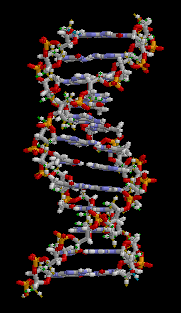Genetics-Part#1) INTRODUCTION : Gene - Isn't That What Makes Us Who We Are?
Hello dear Steemians.
You must have wondered how come your body is different from that of the others in your family, how is that you have inherited some characteristics from you parents, why your siblings are a bit different from you as far as the traits are concerned event though you have common parents !
We in our journey through this blog series will be going through how all this happens and try to understand the intricacies of the processes involved !
[Author : Barcroft TV, Youtube]
INTRODUCTION
- THE BUILDING BLOCKS OF OUR BODY
- Cells : You must be most probably aware that our bodies are made up of different organ systems made up of various organs which are further made up of different kinds of tissues each specialized for the particular need of the organ in which it is found. The tissues are further made up of cells. So, cells can be thought of as the very basic repetitive units that can come together in large numbers, differentiate, and get specialized to efficiently divide among themselves all the essential vital organismic functions necessary for the proper function and survival of the organism (in our case - human).
- Digging into a cell : A cell in general contains various cell organells (which act as if they were the organs of the organism called "cell"!) like the mitochondria - the power-house of the cell, the nucleus - can be thought as the brain/controller of the cell containing all the genetic/hereditary code in the form of DNA or RNA and many other organells (See figure below) !
Structure of a typical Animal Cell
[Source : Wikimedia Commons, Author : By LadyofHats (Mariana Ruiz) - Own work using Adobe Illustrator. Image renamed from Image:Animal cell structure.svg, Public Domain, https://commons.wikimedia.org/w/index.php?curid=4266142]
Yeah! But, cells from different organisms are different, for example a plant cell will be very different from an animal cell most importantly because of the presence of a central large "Store-room" which the plants have, this is an organell called vacuole and as already mentioned, this is used by the plant cell to store wastes, food and other stuff. This is also found in animal cells, but is very small in size, and is present in more than one copies.
Structure of a typical Plant Cell
[Source : Wikimedia Commons, Author : By LadyofHats - Self-made using Adobe Illustrator. (The original edited was also made by me, LadyofHats), Public Domain, https://commons.wikimedia.org/w/index.php?curid=844682]
- Nucleus : This is what the nucleus essentially is (See figure below)!
Structure of the Nucleus
[Source : Wikimedia Commons, Author : By BruceBlaus. When using this image in external sources it can be cited as:Blausen.com staff (2014). "Medical gallery of Blausen Medical 2014". WikiJournal of Medicine 1 (2). DOI:10.15347/wjm/2014.010. ISSN 2002-4436. - Own work, CC BY 3.0, https://commons.wikimedia.org/w/index.php?curid=28223971]
- Nuclear Pores : These are essentially pores in the nuclear membrane which allow substances, and genetic material in the form of mRNA(Consider the DNA contained inside the nucleus to be a book with millions of pages called "genes", very often a student from the school called cell comes in to obtain "photocopies" (not exact copies) of pages required by him/her, the photocopied pages are mostly in the form of mRNA - not the exact copies of that portion of DNA, but rather copy of a single strand of the double stranded DNA with slight modifications) to move out of the nucleus.
- Nuceolus : This is the main dense hub of the nucleus that contains all the genetic material.
- Chromosomes : Nucleus contains genetic information in structures called chromosomes. Each chromosome is a single long strand of DNA. (The total length of DNA in a single human cell is approximately 3Km, considering there are a total of 23 pair of chromosomes packed in a single human cell a few micrometers wide, isn't that amazing?!! Below : Cell-->Chromosome-->DNA, just carefully observe how efficiently the DNA is packed, and also the different levels of packing. Source - Pixabay)

- DNA : DNA is the abbreviation for Deoxyribo Nucleic Acid.
- Nucleic Acid = polymer of nuleotides
- Nucleotide = Nucleoside + phosphate
- Nucleoside = Pentose sugar + Nitrogenous bases
- So, DNA = Pentose sugar + Nitrogenous bases + Phosphate
Double Helical Structure of DNA
[Source : Wikipedia, Author : By brian0918� - Own work, Public Domain, https://commons.wikimedia.org/w/index.php?curid=404735]
- Genes : Different parts of the chromosome code for different proteins (which are the most essential for the expression of any trait in an organism). Each single continuous section of the chromosome effectively coding for a single protein is called a gene. The location on the chromosome where a particular gene lies is called its locus (it is sort of an address of the gene on the chromosome)
Okay, now before we move ahead, let's have some more apetizers to keep ourselves interested. Biology is not to bore !
The Green Fluorescent Protein(GFP)
[Source : Wikimedia Commons, Author : By see above - Ingrid Moen, Charlotte Jevne, Jian Wang, Karl-Henning Kalland, Martha Chekenya, Lars A Akslen, Linda Sleire, Per Ø Enger, Rolf K Reed, Anne M Øyan and Linda EB Stuhr: Gene expression in tumor cells and stroma in dsRed 4T1 tumors in eGFP-expressing mice with and without enhanced oxygenation. In: BMC Cancer. 2012, 12:21. doi:10.1186/1471-2407-12-21 PDF, CC BY 2.0, https://commons.wikimedia.org/w/index.php?curid=18345103]
Ever seen fluorescent mice like these...? Well. this is the magic of fluorescent protein coding genes inserted into the mice's DNA !
Let's know more about the GFP...
[Author : https://www.youtube.com/channel/UC1XRLzoLZx3BiZkCFYVWSyA]
Some important terms and facts
A. Genetics : the branch of biology that deals with heredity and variation .
B. Gene : a segment of DNA that produces a functional product which in most cases is a polypeptide (basically a polymer of amino acids or to state simply - a protein)
Amino Acids
These are organic compounds containing an amine and carboxyl functional groups along with an attached side chain specific to the amino acid.
[Source : Wikimedia Commons, Author : By GYassineMrabetTalk✉This W3C-unspecified vector image was created with Inkscape. - Own work, Public Domain, https://commons.wikimedia.org/w/index.php?curid=2551977, License : Public Domain]
C. Each cell contains many different types of proteins which determine the cell structure and function.
D. All of the proteins that a cell makes at a given time is often known as the proteome.
E. Enzymes : are a particular types of proteins which accelerate chemical reactions. They are of two broad types :
- Anabolic Enzymes : responsible for synthesis of cellular macro-molecules.
- Catabolic Enzymes : are responsible for the breakdown of larger molecules to smaller ones, with the help of externally supplied energy.
F. DNA stores the information for protein synthesis : DNA is composed of a linear sequence of nucleotides --> made up of nitrogenous bases : adenine (A), thymine (T), guanine (G), or cytosine (C) --> these base sequences form the genetic code.
G. Flow of genetic information : DNA ----(transcription)---> mRNA ----(translation)----> inactive protein precursor ----> (proper folding of precursor) ---> active protein
H. Trait : trait is any characteristic that an organism displays. They are of the following types : - Morphological Traits : those that affect the appearance of an organism .
- Physiological Traits : affect the ability of an organism to function.
- Behavioural Traits : affect the ways that an organism responds to its environment.
I. ALLELE : is a variant of a given gene. Generally two alleles of the same gene will differ in the potency in terms of the amount of proteins they can synthesise, which may affect the direction of natural selection, allele dominance etc.
J. Genetic Variation : describes the differences in inherited traits among individuals within a population.
K. Morphs : contrasting forms of a single species.
Natural Selection - The Pepper Moth Morphs
[Author : By Chiswick Chap - Self-published work by Chiswick Chap, CC BY-SA 3.0, https://commons.wikimedia.org/w/index.php?curid=880130]
[Author : world videos]
L. Mutations : sudden genetic variation in the DNA of an organism due to environmental factors. These may have the following effects :
- In many cases, gene mutations alter the expression or function of the protein that the gene specifies.
- A large segment of a chromosome can be lost, rearranged, or reattached to another chromosome.
- Variation may also occur in the total number of chromosomes.
M. Types of genetic variations due to mutations : - Variations within the sequences of genes
- Chromosome variation—a change in chromosome structure or number or both. For example - Down's Syndrome. (Watch the video below)
[Author : [Barcroft TV](https://www.youtube.com/channel/UCfwx98Wty7LhdlkxL5PZyLA, Youtube)]
N. Environment can also effect trait expression : A variety of factors in an organism’s environment profoundly affect its morphological and physiological features. For example, a person’s diet greatly influences many traits such as height, weight, and even intelligence.A variety of factors in an organism’s environment profoundly affect its morphological and physiological features. For example, a person’s diet greatly influences many traits such as height, weight, and even intelligence.
--------------End of Part-1, To be continued------------
Bibliography
- https://en.m.wikipedia.org/wiki/Amino_acid
- Genetics - Analysis and Principles, 4th Edition by Robert J. Brooker.
- https://en.m.wikipedia.org/wiki/Cell_nucleus
Special Thanks
Barcroft TV for creating such amazing, informative and genuine documentaries on various topics in biology.

[Mr.Darwin from Pixabay!]
Keep Evolving...!
M.Medro









Congratulations @medro-martin! You have completed the following achievement on the Steem blockchain and have been rewarded with new badge(s) :
Click here to view your Board
If you no longer want to receive notifications, reply to this comment with the word
STOP